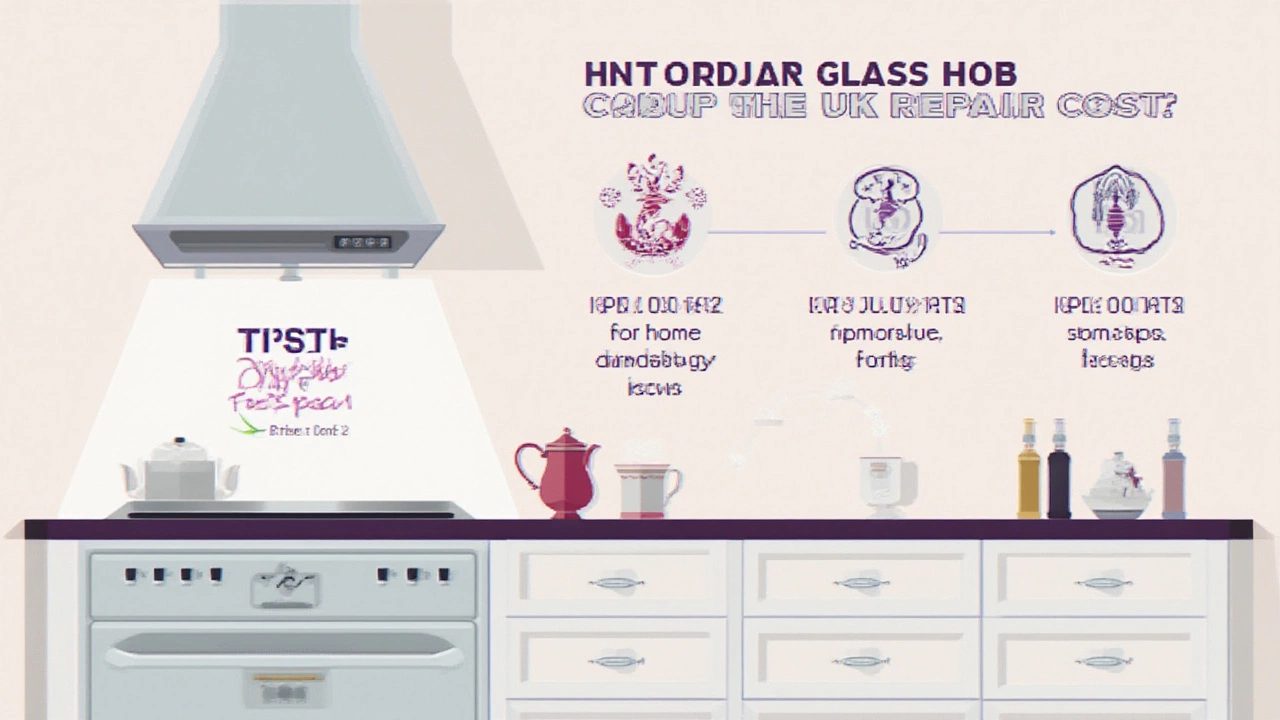Cracked or shattered glass hobs can turn an ordinary dinner prep into a kitchen disaster. You might be surprised to learn just how delicate these surfaces are, given they're right in the blast zone of pots, pans, and spilled stew. Yet, it's that sleek glass look everyone wants in their modern kitchen. So, when a slip of the hand or a rogue jar chips the surface, you're left eyeing your wallet and wondering, 'How much is this going to set me back?' The costs can feel mysterious and even intimidating, but I'm about to drag those numbers out in the open and show you exactly what's going on behind the scenes of a glass hob repair job.
Why Glass Hobs Break and When You Need to Act Fast
First off, glass hobs are crafted from tempered ceramic glass. They’re strong, up to a point—but even microwave glass proves more flexible under stress. While the engineered glass on a hob can handle extreme temperatures, just one sudden impact with a heavy pot or a quick temperature swing (think frozen peas on piping-hot glass) can cause stress cracks or even serious shattering.
Nothing spreads anxiety like seeing a spiderweb crack on an appliance you use daily. What’s truly important: cracks and chips usually start small but can spread or even cause the hob to short-circuit. Safety is the real issue here. According to a 2023 report from the UK Office for Product Safety, up to 18% of kitchen appliance fires start from damaged electric cooking equipment, and cracked electric hobs figure into that. Glass acts as an insulator, so a breach means the heating elements might be exposed—not just inconvenient, but dangerous.
If you spot a hairline crack, don’t ignore it. Continuing to cook over even a tiny fault can lead to a quick domino effect. You risk electric shocks. In rare cases, shattered particles can even cause cuts. The advice from appliance manufacturers? Stop using the zone immediately and turn off the hob at the wall; then figure out your next step. Hoping it’ll fix itself isn’t an option, sadly.
This leads to your options: Should you patch, replace, or pay for a full pro repair? Each has its cost, but a quick fix isn’t always the safest option. Now let’s dive into the numbers behind each path.
The Real Costs of Fixing a Glass Hob—Item by Item
Let’s talk pounds and pence. In 2025, the average cost for fixing a glass hob in the UK swings widely, ranging from about £100 for a small local job up to £450 if you need full glass replacement. Brand and model really matter—that high-gloss Bosch, Neff, or Miele hob? Replacement glass is usually more expensive and sometimes has to be ordered straight from the manufacturer, which means a higher bill.
| Type of Repair | Average Cost (GBP) | Time to Complete |
|---|---|---|
| Minor Crack or Chip Repair | £100 - £180 | 1-2 hours |
| Glass Panel Replacement | £180 - £450 | 2-4 hours |
| Full Hob Replacement | £350 - £750+ | 2-5 hours |
Those are 2025’s numbers, and yes, prices have ticked up about 10% since 2023 thanks to global logistics snags and increased demand for premium kitchen finishes. If you’re in London, expect to pay toward the higher end—urban rates can be 20% above national averages.
Keep in mind, the cost you see on a quick quote might not include the callout fee, which can vary between £30 and £80. Some repair engineers wave that fee if you book a repair, so always ask. Then there’s VAT, typically 20%, tacked on most bills for parts and labour.
Don’t forget the fine print: home insurance usually doesn’t cover glass hob breakage, calling it ‘accidental damage’, which belongs to its own insurance category. Unless you’ve upgraded your policy, you’re likely out-of-pocket for the whole deal.
What pushes costs up? Here are a few concrete factors:
- Brand and availability of replacement glass—rare or premium units cost more.
- Whether heating elements were damaged by the break (this adds at least £70-£150).
- Your location—major cities = higher rates.
- Emergency callouts—needed when the hob is unsafe and must be fixed the same day, tack on another £50-£120.
That’s the money side. But let’s get into why the costs break down the way they do.

What’s Involved in a Glass Hob Repair?
There’s more to fixing these beauties than swapping out a single piece of glass. Glass hob repairs aren’t a quick splash-and-dash. Most of the time, you can’t glue or fill in a crack safely—heat and electrical safety rules say replacement is the gold standard.
Repair techs start by powering down the unit completely and unplugging it—no shortcuts here; safety is king. Then, they’ll remove the hob from the countertop, which sounds simple but actually requires patience to avoid damaging the worktop or any surrounding trim. Once the hob’s out, they lift the glass carefully—hobs can be heavy and some models use tricky clips or specialty screws. No universal fittings here.
If just the glass is being replaced, they’ll disconnect the glass from the control panel and heating rings underneath. In older or integrated hobs, or models with touch controls, this can be time-consuming since the wiring is usually tightly packed.
- Fitters have to make sure the new glass is level, perfectly sealed, and lines up flush with the controls or burners. Any gap means spillages or further cracks down the road.
- They’ll test every burner after the swap, checking for electrical safety (with a PAT tester), and making sure temperature sensors are working.
If the break has also scorched a heating element or tripped a fuse when the glass went, those parts need checking and possibly swapping. Add 30-60 minutes for each faulty part, plus the extra cost of components.
Most pro engineers finish a straightforward glass swap in about 2 to 3 hours. Odd-sized or under-counter models might take longer—especially induction hobs, which are packed with electronics. If your appliance is older than 10 years, sometimes parts are discontinued and a full hob swap makes more sense than chasing rare components.
DIY is risky here: glass for hobs is not just ‘glass’ you can buy online to size—it’s a heat-resistant, engineered panel specific to brand, model, and sometimes even individual batch. Fit the wrong one, and the next time you boil the kettle, it might just pop or short out. So yes, it usually pays to call in a pro unless you’re replacing a very old, purely mechanical hob.
Is It Worth the Cost—or Should You Replace Your Hob?
You’re probably thinking: When does repair cross the line into ‘just buy a new one’? The basic math: If the cost to fix the hob is over 40-50% of the price of a new one, and your model is old or unreliable, then a full replacement starts to make more sense.
For example, the average price for a mid-range new glass hob in 2025 runs around £350-£600, according to appliance retailer AO.com’s latest price index. Add a professional install—installers typically charge £80-£150—and recycling the old hob (£20-£40), and now you’ve got a full picture.
- Newer hobs come with better warranties, usually at least two years for parts and labour (premium brands like Miele offer up to five).
- Modern induction hobs now pack better energy efficiency, which can save up to £55 a year on electricity for a family of four, according to the Energy Saving Trust.
- If your old hob is slowing down, frequently resetting, or showing ‘error’ codes, pouring money into a repair starts looking like throwing cash at a lost cause.
So, if your hob is five years old or less and the damage is minor, repairs nearly always win for cost. Over eight years old, fickle or hard-to-source models are usually worth replacing. Brands known for lasting ages, like Siemens or Smeg, may tip the balance towards repair, provided you can nail down replacement glass.
The big tip: Ask a pro for a quote that includes all potential extra costs—parts, labour, VAT, callout, and worst-case parts. Then, compare that sum to prices for a new unit, factoring in installation and disposal. This way you’re not left wincing when the bill lands.

Tips to Prevent Glass Hob Damage and Save on Repairs
Of course, the cheapest way to fix a glass hob is never needing to fix it at all. Prevention beats cure—here’s how you can dodge the most common causes of glass hob heartbreak:
- Don’t put hot pans straight from the oven onto a cold hob (and vice versa).
- Wipe up sugary spills while the hob is warm, not cold. Burnt sugar can stick and weaken the glass, increasing stress over time.
- Invest in good-quality, flat-bottomed cookware. Uneven pans don’t transfer heat right and can cause hotspots—one of the leading causes of shocks to the glass.
- Never climb or lean on the hob while reaching for something—it’s just not built for the extra load.
- Read your manufacturer’s warranty for what’s covered and how to keep it valid. Some brands void the warranty for using harsh chemicals or abrasive sponges.
- Consider extended warranties if you’re buying premium. They may seem pointless, but for high-end appliances with glass components, they often pay for themselves with just a single repair claim.
A surprising stat: 38% of glass hob failures happen during routine cleaning—dropping glass bottles, using cracked porcelain, or scrubbing way too hard. Treat the glass as you would a phone screen: careful, regular attention with the right tools.
In the end, even the most careful chef might get unlucky—the odd clatter or dropped dish is just life. When that day comes, at least you’ll know the numbers, the process, and ways to keep your next hob trouble-free for years. The modern glass hob: Eye-catching, hard-working, but not nearly so mysterious as repair shops would like you to think.

I am an expert in the services industry with a focus on appliance repair. My passion lies in understanding how things work and educating others in simple, engaging ways. This enthusiasm fuels my writing, where I delve into topics around appliance maintenance and troubleshooting. I aim to make these subjects clear and accessible to all readers.